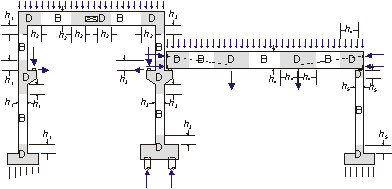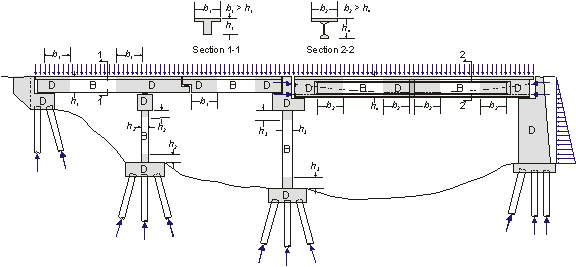In selecting the appropriate design approach for structural concrete, it is useful to classify portions of the structure as either B – (Beam or Bernoulli) Regions or D – (Disturbed or Discontinuity) Regions. B – Regions are parts of a structure in which Bernoulli’s hypothesis of straight-line strain profiles applies. D–Regions, on the other hand, are parts of a structure with a complex variation in strain. D–Regions include portions near abrupt changes in geometry geometrical discontinuities) or concentrated forces (statical discontinuities). Based on St.Venant’s principle, the extent of a D–Region spans about one section depth of the region on either side of the discontinuity.
Figure 1 and Figure 2 show examples of the division between B – Regions and D–Regions in building and bridge structures, respectively. In the figures, the unshaded area with a notation B indicates B–Region, and the shaded area with a notation D is used to indicate D–Region. The notations h1, h2, h3, … are used to denote the depth of structural members. The notations b1 and b2 denote the flange width of structural members.
Most design practices for B-Regions are based on a model for behavior. As examples, design for flexure is based on conventional beam theory while the design for shear is based on the well-known parallel chord truss analogy. By contrast, the most familiar types of D-Regions, such as deep beams, corbels, beam-column joints, and pile caps, are currently still designed by empirical approaches or by using common detailing practices. For most other types of D-Regions, code provisions provide little guidance to designers. The Strut-and-Tie Method (STM) [1-3] is emerging as a code-worthy methodology for the design of all types of D-Regions in structural concrete.
You can read by downloading this file Strut and Tie Method Theori




komen(g) terbaru….